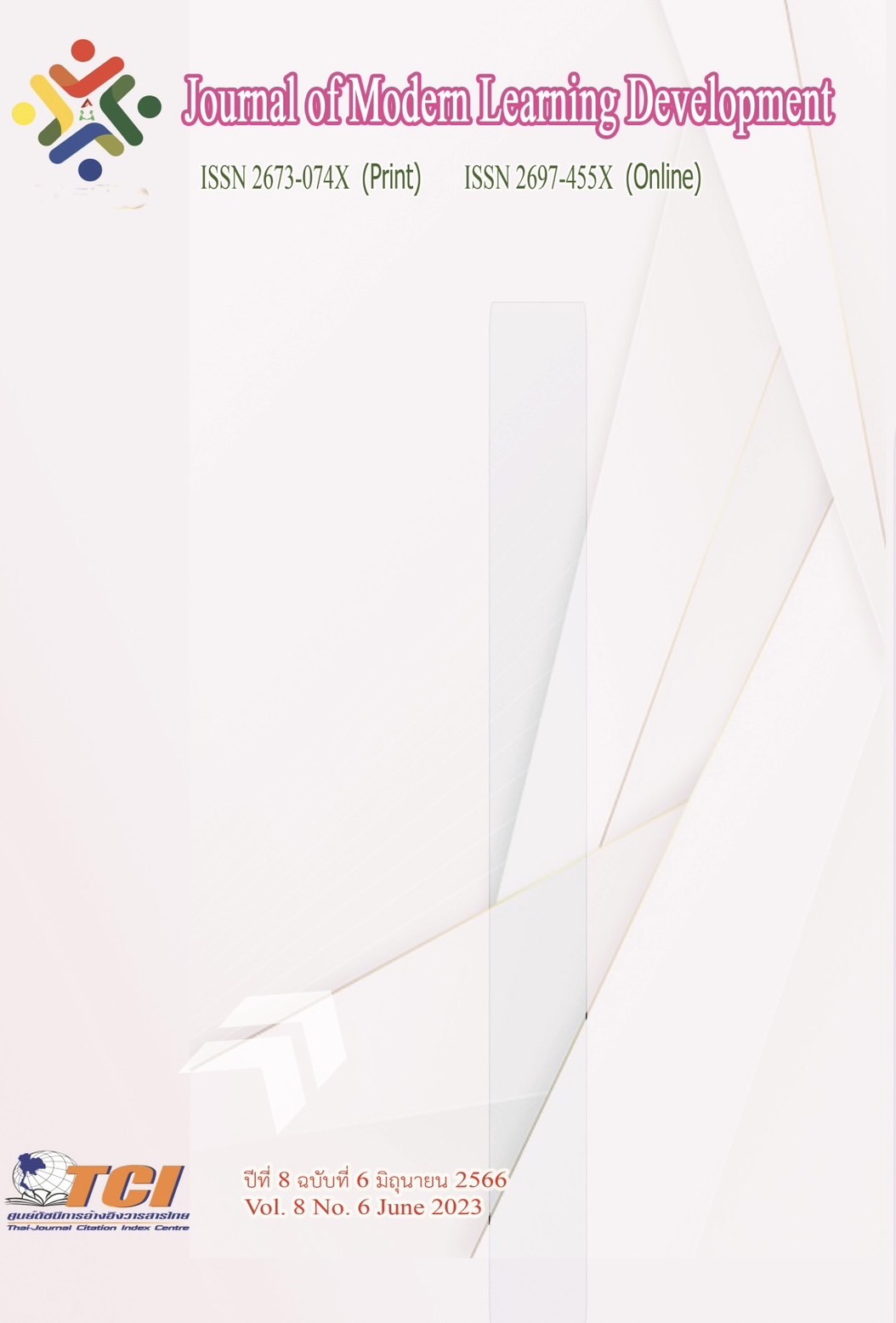Systematic Information Administration according to the National Standards of Early Childhood Development Center of Child Development Center under Subdistrict Organization, Muang District, Lampang Province
Main Article Content
Abstract
This research had a purpose to study the data administration conditions and guidelines of Systematic Information Administration according to the National Standards of Early Childhood Development Center of Child Development Center under Subdistrict Organization Muang District, Lampang Province. in two steps were conditions and guidelines of Systematic Information Administration according to the National Standards of Early Childhood Development Center. The research include a sample of 58 people from child development centers. In the academic year 2020. The samples consisted of the 14 heads of the Child Development Center, 20 teachers, 24 childcare teacher assistants, The research instrument used a rating scale questionnaire, which created by researcher. The data were analyzed by using frequency, percentages, mean and standard deviation.
Results of the study found that :
1. The conditions of systematic information administration, in general, the operated in high level ( = 4.31), when sorted by average from highest to lowest, found that, Controlling performed at the highest level, with the highest average (= 4.56), and followed by performed at the high level, namely Leading (= 4.41) , Organizing (= 4.15 ) and Planning (= 4.14 ) respectively.
2. Guidelines for the systematic information administration according to the POLC consists of 4 approaches as follows :
1) Planning : Problem condition survey and data type requirements, make a data management plan and personnel development plans for information operations of the Child Development Center.
2) Organizing : Establish an information agency, determine the workload and operational guidelines of the information agency, and the person responsible for the information work of the Child Development Center.
3) Leading : Conduction personnel development activities to gain knowledge and understanding of the operations of the Child Development Center information agency and operate according to the data management plan.
4) Controlling : Evaluate the performance of the child development center's data unit, evaluate the results, summarize and report the results of the data management plan implementation and taking advantage of the information, for the improvement and development of systematic information administration.
Article Details
References
กลุ่มงานส่งเสริมการจัดการศึกษาปฐมวัยและศูนย์พัฒนาเด็กเล็ก. (2562). มาตรฐานสถานพัฒนาเด็กปฐมวัยแห่งชาติ. กองส่งเสริมและพัฒนาการจัดการศึกษาท้องถิ่น กรมส่งเสริมการปกครองท้องถิ่น. ออนไลน์. สืบค้นเมื่อ 21 มีนาคม 2563. แหล่งที่มา: http://www.dla.go.th/upload/ document/type2/2019/3/21360_1_1551673939193.Pdf.
คณะกรรมการการศึกษาขั้นพื้นฐาน, สำนักงาน. (2560). หลักสูตรการศึกษาปฐมวัย พุทธศักราช 2560. สำนักวิชาการและมาตรฐานการศึกษา กระทรวงศึกษาธิการ. กรุงเทพมหานคร: ชุมนุมสหกรณ์การเกษตรแห่งประเทศไทย.
คณะกรรมการการศึกษาขั้นพื้นฐาน, สำนักงาน. (2561). คู่มือหลักสูตรการศึกษาปฐมวัย พุทธศักราช 2560 สำหรับเด็กอายุต่ำกว่า 3 ปี. สำนักวิชาการและมาตรฐานการศึกษา กระทรวงศึกษาธิการ. กรุงเทพมหานคร : ชุมนุมสหกรณ์การเกษตรแห่งประเทศไทย.
บุญชม ศรีสะอาด. (2556). การวิจัยเบื้องต้นฉบับปรับปรุงใหม่. กรุงเทพมหานคร: สุวีริยาสาส์น.
แผนแม่บทภายใต้ยุทธศาสตร์ชาติ. (2562). 11. การพัฒนาศักยภาพคนตลอดช่วงชีวิต (พ.ศ. 2561 – 2580). ออนไลน์. สืบค้นเมื่อ 23 เมษายน 2563. แหล่งที่มา: http://nscr.nesdb.go.th/ wp-content/uploads/2019/04/11-ศักยภาพคนตลอดช่วงชีวิต.pdf
ภิญญาพัชญ์ แหวนนาค และ พรเทพ รู้แผน. (2562). การนำเสนอแนวทางการบริหารเทคโนโลยีสารสนเทศและการสื่อสารของโรงเรียนมาตรฐานสากล ในสังกัดสำนักงานเขตพื้นที่การศึกษามัธยมศึกษา เขต 3 จังหวัดพระนครศรีอยุธยา. วารสารวิจัยราชภัฏกรุงเก่า. 6 (1), 65 – 72.
มารยาท โยทองยศ และปราณี สวัสดิสรรพ์. (2557). การกำหนดขนาดของกลุ่มตัวอย่างเพื่อการวิจัย.ศูนย์บริการวิชาการ สถาบันส่งเสริมการวิจัยและพัฒนานวัตกรรม. ออนไลน์. สืบค้นเมื่อ 23 เมษายน 2563. แหล่งที่มา: http://www.fsh.mi.th/km/wp-content/uploads/2014/04/resch.pdf
มณฑิรา คงยิ่ง. (2561). การจัดระบบสารสนเทศทางการศึกษาของโรงเรียนประถมศึกษา สังกัดสำนักงานเขตพื้นที่การศึกษาสมุทรสาคร. การค้นคว้าอิสระ ครุศาสตรมหาบัณฑิต สาขาวิชาการบริหารการศึกษา. บัณฑิตวิทยาลัย: มหาวิทยาลัยราชภัฏสุราษฎร์ธานี.
รัตนวรรณ นันทเกษตร. (2560). การจัดระบบสารสนเทศในสถานศึกษาตามการรับรู้ของครูสังกัดสำนักงานเขตพื้นที่การศึกษาประถมศึกษาสุราษฎร์ธานี เขต 1. ภาคนิพนธ์ ครุศาสตรมหาบัณฑิต สาขาวิชาการบริหารการศึกษา. บัณฑิตวิทยาลัย: มหาวิทยาลัยราชภัฏสุราษฎร์ธานี.
ศึกษาธิการ, กระทรวง. (2563). ศธ.เตรียมแผนพัฒนาเด็กปฐมวัย วางรากฐานอนาคตชาติ. ออนไลน์. สืบค้นเมื่อ 10 ธันวาคม 2563. แหล่งที่มา: https://www.moe.go.th/ศธ-เตรียมแผนพัฒนาเด็กปฐมวัย.
สงบ อินทรมณี. (2562, มกราคม – มิถุนายน). การบริหารสถานศึกษาในยุคดิจิทัล. วารสารวิชาการมหาวิทยาลัยการจัดการและเทคโนโลยีอีสเทิร์น. 16 (1), 353 – 360.
ส่งเสริมการปกครองท้องถิ่น, กรม. (2560). คู่มือแนวทางการจัดทำหลักสูตรของศูนย์พัฒนาเด็กเล็กในสังกัดองค์กรปกครองส่วนท้องถิ่น. กองส่งเสริมและพัฒนาการจัดการศึกษาท้องถิ่น,กระทรวงมหาดไทย. นนทบุรี: ชุมนุมสหกรณ์การเกษตรแห่งประเทศไทย.
ส่งเสริมและพัฒนาการจัดการศึกษาท้องถิ่น, กอง. (2562). แนวทางการดำเนินการบันทึกข้อมูลนักเรียนและเด็ก ในระบบข้อมูลสารสนเทศทางการศึกษาท้องถิ่น. กลุ่มงานยุทธศาสตร์การพัฒนาการจัดการศึกษาท้องถิ่น. ออนไลน์. สืบค้นเมื่อ 11 ธันวาคม 2563. แหล่งที่มา: https:// www.uthailocal.go.th/dnm_file/govdoc_stj/89975930_center.pdf
อรอุษา ปุณยบุรณะ และประเสริฐ อินทร์รักษ์. (2017). การบริหารเทคโนโลยีสารสนเทศและการสื่อสารของโรงเรียนสาธิต. Journal of Nakhonratchasima College. 11 (2), 23 – 37.


